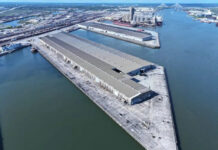Diesel particulate emissions from Port of Oakland maritime operations are down 81 percent since 2005, according to data released on August 30, 2018. As a result, the Port expressed confidence in reaching a self-imposed target: 85 percent emissions reduction by 2020.
“We continue to make progress toward the goal we have set,” said Port of Oakland Environmental Programs and Planning Director Richard Sinkoff. “With cooperation from our partners in the cargo-moving business we firmly believe we’ll fulfill our commitment to cleaner air in Oakland and in our region.”
San Francisco Bay Area environmental consultancy Ramboll reported Oakland’s improvement in a 100-page emissions inventory of 2017 Port activity. The results show a 5 percent drop in seaport emissions in the past two years. The results are significant for Oakland workers, harbor truckers and residents near the Port who benefit from cleaner air.
Oakland’s Board of Port Commissioners adopted an 85-percent diesel emissions reduction target in 2008. The Board set 2005 as its measurement baseline.
According to the Ramboll report, Oakland diesel emissions have plummeted since 2005 despite a 6 percent cargo volume increase. It attributed the improvement to a series of developments, including:
- A Port program that purged older, exhaust-belching big rigs from the fleet of trucks hauling containers in Oakland;
- Regulations that require container ships to use cleaner-burning low sulfur fuel and switch off engines and plug into landside power while at berth; and
- Fewer vessel and truck visits to the Port.
Ramboll reported that vessel traffic in Oakland has declined 15 percent since 2005, even though cargo volume is up. That’s the result of cost-conscious ocean carriers loading more containers onto fewer but larger ships. The report also stated that truck traffic is down by more than 500,000 trips a year. It attributed the reduction to efficiency improvements at the Port. Efficiencies include night gates and appointment systems that make it easier for harbor drivers to transact business.
Last month, the Port publicly previewed the draft of a new clean air plan intended to extend its emissions reduction program for decades. The air quality blueprint reiterates Oakland’s 2020 commitment and proposes new emissions control measures for diesel and greenhouse gases. The plan is undergoing community review. It’s expected to be finalized by year end.





